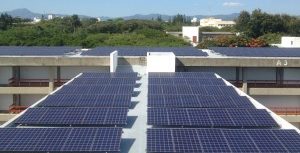Togo
In Togo, global warming phenomenon is accompanied by a trend towards the drying up of the climate, which seriously affects the various sectors of activity and human health. Observations of the climate in Togo over the period 1961-2012 reveal a warming of 1°C compared to the period 1961-1985. The scenarios developed, whatever the assumptions, clearly show that climate change is a real concern for the country and that warming trends will increase in the short, medium and long terms with consequences that would be very damaging.
Togo’s commitment under the revised NDCs: Togo intends to deploy measures in a number of its sectors’ economy to reduce its emissions. Contributions could come from the energy, industrial processes and product use, from agriculture, forestry and other land use and the waste sectors. These mitigation measures are guided by a long-term low-carbon development aspiration that promotes the implementation of the Government’s Roadmap (FDR 2020-2025), agricultural policy and the fight against poverty.
Conditional scenario: Togo had expressed a conditional target commitment to reduce greenhouse gas (GHG) emissions by 20% compared to an uncontrolled development scenario. By comparing the effective reduction in GHG emissions obtained in 2020 with that forecast for the same year in the initial NDCs, it appears that Togo has reached an additional reduction of 2,915 Gg CO2-eq, or 10.06%.In the proposed approach for the conditional mitigation scenario of the revised NDCs, the Togolese State undertakes, if it receives the required support, to achieve a 30.06% reduction in GHG emissions compared to the reference scenario by 2030 (9305.59 Gg CO2-eq) without compromising its policy of food self-sufficiency or even its sustainable development.
Unconditional scenario: In its revised NDCs, Togo commits to an unconditional contribution to reducing its GHG emissions by 20.51% by 2030 (6,236.02 Gg CO2-eq). The combined unconditional and conditional contributions therefore correspond to a reduction of 50.57% in GHG emissions compared to the reference scenario (baseline), which is equivalent to an estimated level of mitigation of 15,378.55 Gg CO2-eq by 2030. The implementation of the revised NDCs requires significant investments between 2020 and 2030 for mitigation and for adaptation in the most vulnerable sectors (agriculture, water resources, forestry and land uses, coastal zone and human settlements). Part of the actions included in the revised NDCs stem from the PND (2018-2022) reflected into ongoing FDR 2020-2025.
Revised NDC financial needs: The revised NDC project portfolio represents 5.537 billion USD of total investment by 2030 to reduce GHG emissions by 50.57% or 15,378.55 Gg CO2-eq compared to the reference scenario through unconditional and conditional combined contributions. The unconditional measures represent 30.79% of the overall projected aid and 69.21% for the conditional measures, an investment estimated at 3.827 billion USD. Several financial instruments, line of credit and donations will be mobilized to finance the revised NDCs. Overall financing by line of credit represents an overall investment of USD 1.117 billion, or 20% of the overall investment, of which USD 408.130 million has already been acquired for unconditional projects. The second financial instrument that can be mobilized is the subsidy that may reach 4.420 billion US dollars. This represents 80% of the overall investment, including around 603.4 million USD for the unconditional part.
- Public-private partnerships
- Identification, design and development of impactful and bankable infrastructure projects,
- Access to green financing opportunities
- MRV process.
- Promote better sanitation
- Recovery in energy of 3.5 Gg (approximately 2.9 million m3) of methane produced at the Lomé landfill site
- Sorting and recovery of 145,000 tons of waste (50,000 tons by composting) intended for burning.
- Promotion of the production of electricity based on renewable sources and hydroelectric energy
- Improvement of the electrical energy distribution network and promotion of energy-saving light bulbs
- Promotion of energy efficiency in households
- Promotion of modern bioenergy for cooking
- Promotion of LPG in households
- Promotion of electric vehicles (program 36 of the government roadmap)
- Promote the processing and recycling of fluorinated gases
- Promote the construction of private and public buildings with thermal insulation materials
- Promote the manufacture of cements composed of less clinker such as portland types with limestone; to the milkman; blast furnace cement
- Integrated development of the agricultural sector through the establishment of an effective strategy for the sustainable management of cultivated lands
- Promotion and sustainable management of hydro-agricultural, hydro-pastoral and agricultural development works and water supply;
- Organization of agricultural value chain
- Modernization of the livestock sub-sector
- Support for fodder reforestation with the introduction of fodder trees on farms with a view to sustained production of quality fodder
- Restoration of existing forest landscapes by promoting the restoration of natural forests, fragile ecosystems and the conservation of biodiversity, by favoring support for projects linked to already organized territories (protected areas, community or village forests, sacred sites), limiting the fragmentation of forest massifs and maintaining the connection of natural habitats
- Improvement of sustainable land management for the reinforcement of carbon sinks and carbon sequestration through “mass development plans” promoted by private forests or community forests or “territorial forest charters” or rural development poles
- Development of urban forestry through the establishment of urban plantations, the promotion and creation of green spaces
- Promotion of the processing of forest products and non-timber by-products and promotion of value chains and market access for processed forest products
- Support the capture of surface water resources by multi-purpose hill reservoirs
- Set up an early warning system to prevent risks
- Support the fight against vector-borne diseases
- Strengthen social protection and the construction of climate-resilient socio-economic infrastructure
- Initiate IGAs for market gardening and fishing communities in the coastal area
- Strengthen the coastal protection system against coastal erosion (natural and artificial)
- Provision of database and information for SCF country profile (31 January 2022).


